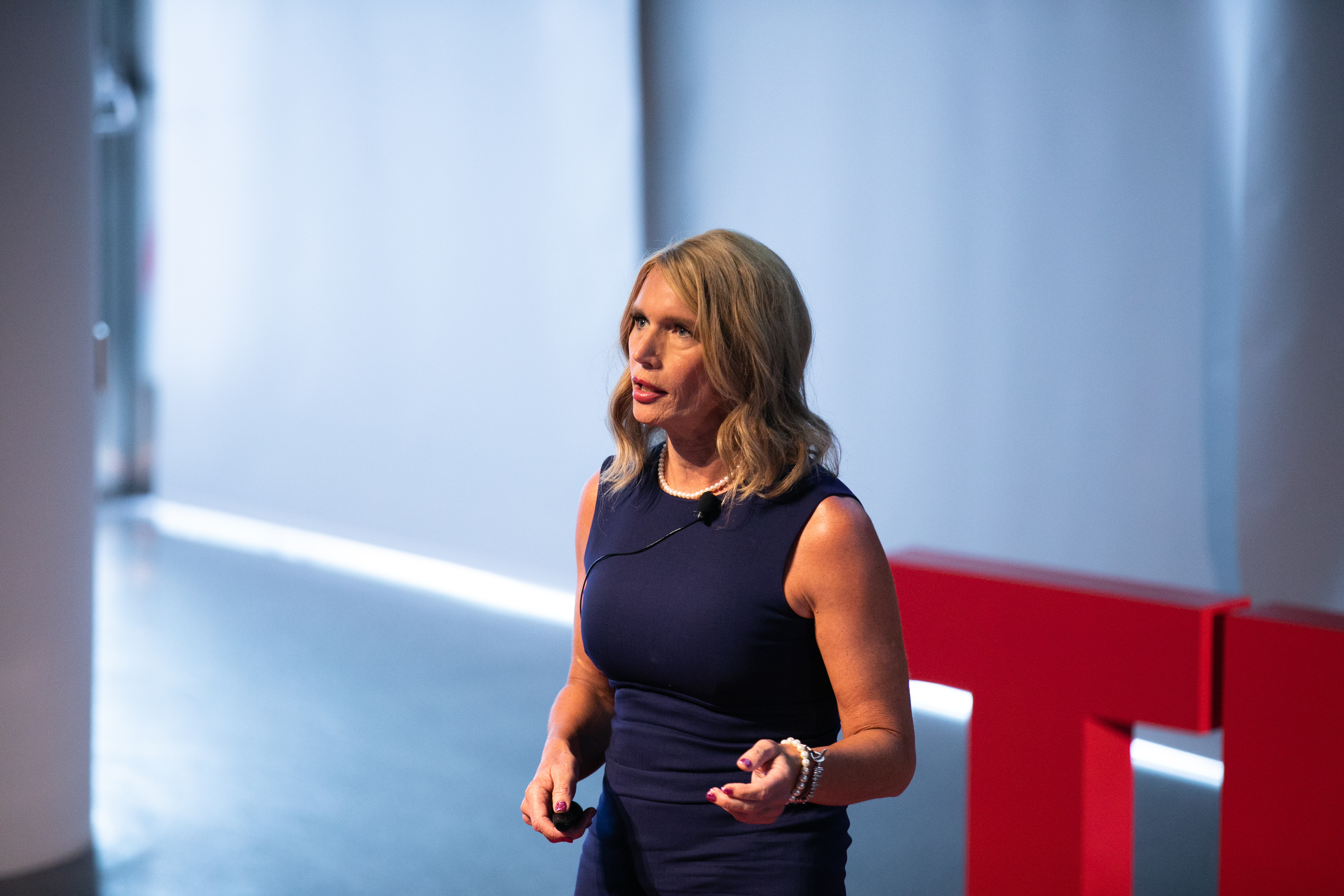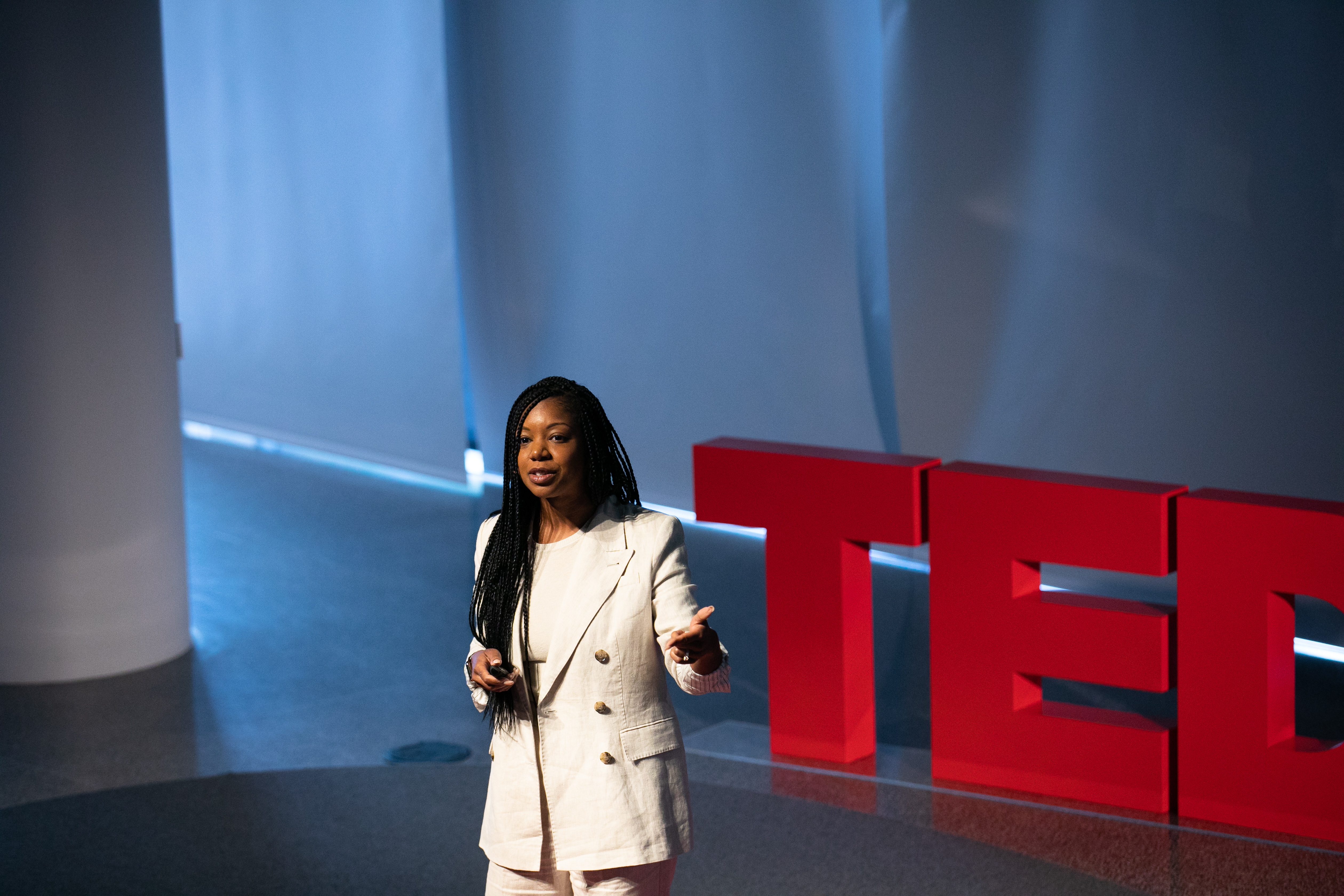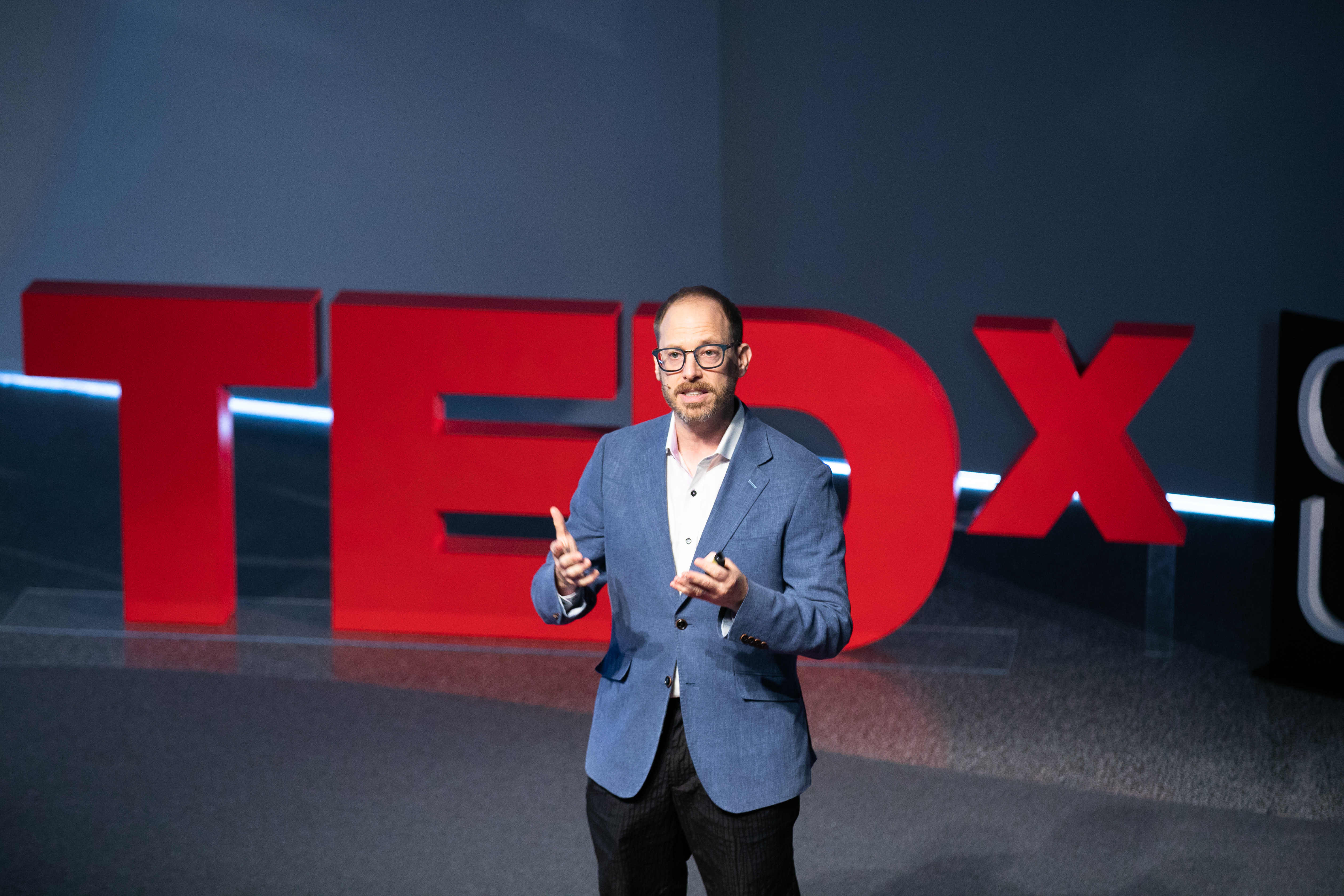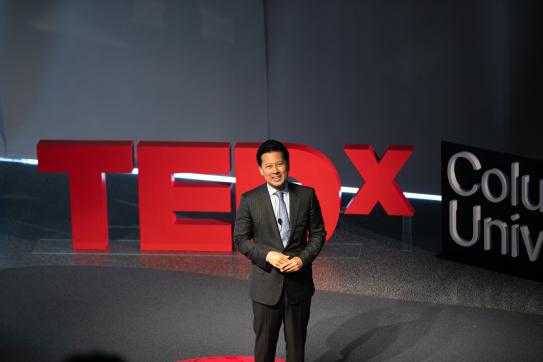On stage at the first-ever TEDxColumbiaUniversity — Excellence Through Equity event, hosted by Columbia Business School, Assistant Professor of Business Wei Cai shared a story about exclusion that hit close to home.
Her parents, both physics professors, had shared near-identical career paths: the same university, advisors, and work institutions. And yet, throughout her work life, her mother’s ideas had been disregarded and ignored, eroding her confidence and eventually forcing her to rely on her husband as her mouthpiece.
Motivated by her parent’s differing experiences, much of Cai’s research focuses on how to increase inclusion and give each voice equal opportunity in the workplace. Across her many studies, Cai says, the upshot is consistent: “Exclusion is harmful not only to individuals but also to organizations.”
At the TEDxColumbiaUniversity event, presentations from faculty, students, and thought leaders across disciplines underscored and expanded upon Cai’s findings. Each of the 14 speakers touched on the ways in which themes of diversity, equity, and inclusion affected their own lives and shared strategies for improving these themes — in the workplace and beyond.
Their insights and suggestions fell into three categories: new approaches to leadership, power, and ambition; new approaches to culture; and new approaches to empirical research.
1. New approaches to leadership, power, and ambition
Cai’s research has tested new systems to improve inclusivity in the workplace — with promising results.
She calls her approach “formalizing the informal,” which means instituting specific protocols to ensure, for example, that companies are hiring only inclusive employees.
In one study, she worked with a firm that implemented a formal culture-fit measurement system in its employee-selection process, where candidates answered questions about how they would behave in hypothetical scenarios. Cai found that employees hired through this formal system performed significantly better — and were more diverse — than those hired outside of it.
Her research findings also emphasize the critical role of leaders in shaping inclusive workplace cultures. In a study that examined the role of CEOs in influencing organizational cultures, Cai and her colleagues found that culture does significantly change after a CEO turnover. In another study, they found that more-diverse boards of directors are critical for increasing diversity and opportunity within organizations.

Adam Galinsky, CBS’s vice dean for diversity, equity, and inclusion and the Paul Calello Professor of Leadership and Ethics, also spoke at the event. He similarly underscored the vital role of leaders in shaping strong working relationships and focused on a phenomenon he calls the “leader amplification effect.” He explained, “When you have power, when you have authority, your comments matter more. As a leader, even your silence can be deafening; when leaders are silent, followers fill the void with worst-case scenarios.”
Galinsky, known for his TED Talk “How to Speak Up for Yourself,” one of the most watched talks with over 7.4 million views, offered an enduring takeaway of the leader amplification effect: Don’t underestimate the impact of complimenting those with less power on a job well done.
In her talk, Claire Shipman — author, former senior national correspondent for Good Morning America, and vice chair of the board of trustees at Columbia University — has spent the past five years unpacking the concept of power itself and the question of why women don’t have more of it.
She pointed out that right now, the share of women around the world in government offices is just 25 percent, and at the current rate, women won’t achieve gender parity for another 130 years. What occurred to her as she studied power was that “maybe we don’t have to change women and everyone else who doesn't fit the system — maybe we can change power.”
This requires a shift in mindset as well as a shift in the way we define power, she said.
Shipman distinguishes between two types of power: power over and power to. She explained “power over is the more traditionally accepted definition, noting, “This version of power is lean, crisp, and hierarchical, and definitely has a forceful edge.”
Power to, on the other hand, doesn’t think of power as a zero-sum game. This is power as an engine through which to get things done.
“Shift your mindset; it may be the single most important thing you can do,” Shipman said. “Power isn’t something to be accumulated; it’s something to be used.”
In his time on the stage (which he shared with a jazz band), Chris Washburne, a musician and Columbia professor of music, described a similar idea using jazz as a metaphor and an exemplar. He explained that early jazz musicians adopted an alternative model of leadership, “what I like to call a fluid leadership model,” he said. “The idea is that anyone on the team is expected to step up and take over whenever they want.” He added, “Sure, you can play jazz alone, but once you have a team that is deeply engaged, you can do something much greater.”

2. New approaches to culture — inside and outside the workplace
Kenji Yoshino, the Chief Justice Earl Warren Professor of Constitutional Law at New York University (NYU), has spent decades thinking about the subtle, pernicious ways in which work cultures encourage people to dampen their authenticity. Sometimes, these forces are so subtle that they’re difficult to identify, but Yoshino insists we must become more skilled at doing so.
In reflecting back on his journey coming to terms with his identity as a gay man, Yoshino identified three phases of coerced conformity: 1) pressure to convert, 2) pressure to pass, and 3) pressure to cover.
In his own experience and in his research, covering took him the most time to diagnose and name. The term is borrowed from sociologist Erving Goffman, who defined it as a state in which people who belong to a stigmatized group often expend an enormous amount of energy keeping that identity from looming large in their interactions with others.
In a survey Yoshino collaborated on with research firm Deloitte, he found that 83 percent of LGBTQ+ individuals reported covering. The same was true of 79 percent of Black respondents, 66 percent of women, and even 45 percent of straight white men. “No cohort was immune,” Yoshino said.
More than half of survey respondents also said that in the workplace, their leaders asked them to cover, and of those, 50 percent said this somewhat or extremely diminished their commitment to their organizations.
What to do? Yoshino offered three suggestions: First, learn to notice when you are covering, and when workplace leaders are encouraging it, insist they do things differently. Second, be better allies to one another. Third, share your own story about covering — especially if you’re a leader.
Tessa West, professor of psychology at NYU, also studies aspects of culture that can be difficult to name. For her part, she examines “cultures of niceness,” in which people fall back into brittle, over-the-top niceness to manage their own anxiety in uncomfortable situations.
Over a series of studies, she has found that many people on the receiving end of this type of “niceness” are racial minorities or other people in front of whom many white people are worried about seeming prejudiced.
One of West’s studies found that in interactions between Black Americans and white Americans, the Black participants became more synchronized, physiologically, with their partners. The more anxious the partners appeared, the more the Black participants linked up to them.
“I think this finding is a little terrifying,” West said. “We often think of our own stress and our own physiology as independent of the people we interact with, but our bodies are not always our own. Our physiology is not always our own. If you spend a lifetime interacting with people who are so nice to you in an effort to control their own anxiety, you could potentially catch that stress, and it could negatively affect your body.”
Part of the solution, she emphasized, begins by offering clear, consistent feedback, rather than falling back on ratcheted-up niceness to smooth an awkward situation when constructive feedback may be called for.
A commitment to DEI also calls for using the right language. Erika Hall, associate professor of organization and management at Emory University, studies semantic prosody — that is, the shades of implied meaning and association a word gains when it absorbs the tone of the words that tend to precede or follow it in natural language.
In various studies, she has examined the real-world consequences of semantic prosody. In one, she and her colleagues created fictitious job applications that were identical except that in one, the candidate was identified as Black, and in the other, as African American.
“The results shocked me,” West said. The white participants who evaluated the African American candidate were twice as likely to say they belonged in a managerial position than the same exact candidate described as Black.
“I’m going to leave you with a simple solution,” West said. “The way semantic prosody works, the Black label is only going to change when the way we use it changes. When Black is used to describe professor, president, and vice president, the lexicon will adapt and soak up the positivity of those surrounding words.”

3. New approaches to research
Juan A. Rios, assistant professor of social work at Seton Hall University, opened with a traumatic memory from childhood: After years growing up in a thriving, supportive neighborhood community in New Haven, Connecticut, his family was displaced when Yale University expanded its faculty housing.
That’s when he knew he wanted to be a social worker, he said.
“I wanted to be that person to give a voice to the voiceless, who often are designed out of the planning process, who are not included in this new community that is being created for us,” Rios said.
Now, as a faculty member at another educational institution, Rios arrives for work every day in a state of “dual consciousness.” The best way he’s found to hold both consciousnesses, Rios said, is to immerse himself in community-engaged scholarship.
The term community-engaged scholarship was coined by Andrew Van de Ven, who defined it as happening when community members, practitioners, academics, and researchers all collaborate together to solve real-world problems.
“Transformation happens when there’s radical inclusion,” Rios said. “That means that all have ownership, all have value, and all have responsibility.”
Valerie Purdie-Greenaway, professor of psychology at Columbia and affiliate professor of management at CBS, has also spent the bulk of her illustrious research career wrestling with the concept of empirical research — and scientific objectivity.
Purdie-Greenaway has studied racial and gender achievement gaps for nearly 20 years. She has found she can reduce these gaps with a simple self-affirmation intervention. In her studies, students were given writing prompts in which they were asked to write for 15 minutes about their deepest personal core values.
“We were able to show that these 15-minute writing exercises lifted Black and Latinx test performance a whole letter grade,” Purdie-Greenaway said. The exercise increased students’ openness to learning, improved health outcomes, and even produced effects that sometimes lasted years after students left school.
But despite the success of her research and its reception, she was struggling with her own mental health. She realized that the problem was that she had to regularly engage with people who seriously believed that “your group isn’t smart; your group shouldn’t be here,” she said. “And they had science to show that. All the while, I had to be neutral and objective, because that’s what the science requires. But psychologically, it starts to wear you down.”
Gradually, her view of science has changed — and expanded, she said. “Once I started thinking about my own values, I changed,” she said. “I started to breathe life into my values and think about what really matters most to me.”
This insight was echoed in a presentation from Maeve DuVally, founder of Glasheen & Co. In reflecting on her gender identity transition, DuVally posited that over the course of our lives, we all have multiple transitions we need to make and we must actively make space in our lives to include them all: new versions of ourselves, new insights, new ways of being.
“My experience has taught me that in order for all of us to make our transitions more unique, rewarding, blissful,” DuVally said, “what we need to do is let go of our expectations and revel in a future of infinite possibilities.”
Watch a slideshow of event speakers here:
